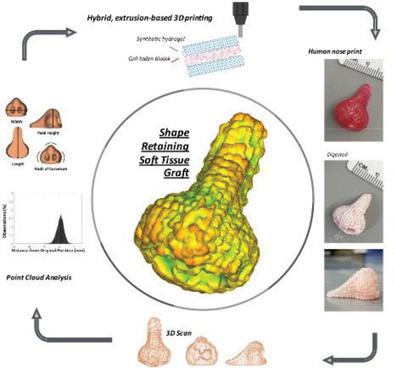当前位置:
X-MOL 学术
›
Adv. Funct. Mater.
›
论文详情
Our official English website, www.x-mol.net, welcomes your feedback! (Note: you will need to create a separate account there.)
Hybrid 3D Printing of Synthetic and Cell‐Laden Bioinks for Shape Retaining Soft Tissue Grafts
Advanced Functional Materials ( IF 19.0 ) Pub Date : 2019-10-15 , DOI: 10.1002/adfm.201907145 Sarah Van Belleghem 1 , Leopoldo Torres 1 , Marco Santoro 1 , Bhushan Mahadik 1 , Arley Wolfand 1 , Peter Kofinas 2 , John P Fisher 1
Advanced Functional Materials ( IF 19.0 ) Pub Date : 2019-10-15 , DOI: 10.1002/adfm.201907145 Sarah Van Belleghem 1 , Leopoldo Torres 1 , Marco Santoro 1 , Bhushan Mahadik 1 , Arley Wolfand 1 , Peter Kofinas 2 , John P Fisher 1
Affiliation

|
Despite recent advances in clinical procedures, the repair of soft tissue remains a reconstructive challenge. Current technologies such as synthetic implants and dermal flap autografting result in inefficient shape retention and unpredictable aesthetic outcomes. 3D printing, however, can be leveraged to produce superior soft tissue grafts that allow enhanced host integration and volume retention. Here, a novel dual bioink 3D printing strategy is presented that utilizes synthetic and natural materials to create stable, biomimetic soft tissue constructs. A double network ink composed of covalently cross‐linked poly(ethylene) glycol and ionically cross‐linked alginate acts as a physical support network that promotes cell growth and enables long‐term graft shape retention. This is coupled with a cell‐laden, biodegradable gelatin methacrylate bioink in a hybrid printing technique, and the composite scaffolds are evaluated in their mechanical properties, shape retention, and cytotoxicity. Additionally, a new shape analysis technique utilizing CloudCompare software is developed that expands the available toolbox for assessing scaffold aesthetic properties. With this dynamic 3D bioprinting strategy, complex geometries with robust internal structures can be easily modulated by varying the print ratio of nondegradable to sacrificial strands. The versatility of this hybrid printing fabrication platform can inspire the design of future multimaterial regenerative implants.
中文翻译:

用于保持形状软组织移植物的合成和充满细胞的生物墨水的混合 3D 打印
尽管临床手术最近取得了进展,但软组织的修复仍然是一个重建挑战。目前的技术,如合成植入物和自体真皮瓣移植,导致形状保持效率低下和不可预测的美学结果。然而,可以利用 3D 打印来生产优质的软组织移植物,从而增强宿主整合和体积保留。在此,提出了一种新颖的双生物墨水 3D 打印策略,该策略利用合成和天然材料来创建稳定的仿生软组织结构。由共价交联聚乙二醇和离子交联藻酸盐组成的双网络墨水充当物理支撑网络,促进细胞生长并实现长期移植物形状保持。将其与混合打印技术中的充满细胞、可生物降解的明胶甲基丙烯酸酯生物墨水相结合,并对复合支架的机械性能、形状保持性和细胞毒性进行评估。此外,还开发了一种利用 CloudCompare 软件的新形状分析技术,扩展了用于评估支架美学特性的可用工具箱。通过这种动态 3D 生物打印策略,可以通过改变不可降解链与牺牲链的打印比率来轻松调节具有坚固内部结构的复杂几何形状。这种混合打印制造平台的多功能性可以激发未来多材料再生植入物的设计。
更新日期:2020-01-17
中文翻译:

用于保持形状软组织移植物的合成和充满细胞的生物墨水的混合 3D 打印
尽管临床手术最近取得了进展,但软组织的修复仍然是一个重建挑战。目前的技术,如合成植入物和自体真皮瓣移植,导致形状保持效率低下和不可预测的美学结果。然而,可以利用 3D 打印来生产优质的软组织移植物,从而增强宿主整合和体积保留。在此,提出了一种新颖的双生物墨水 3D 打印策略,该策略利用合成和天然材料来创建稳定的仿生软组织结构。由共价交联聚乙二醇和离子交联藻酸盐组成的双网络墨水充当物理支撑网络,促进细胞生长并实现长期移植物形状保持。将其与混合打印技术中的充满细胞、可生物降解的明胶甲基丙烯酸酯生物墨水相结合,并对复合支架的机械性能、形状保持性和细胞毒性进行评估。此外,还开发了一种利用 CloudCompare 软件的新形状分析技术,扩展了用于评估支架美学特性的可用工具箱。通过这种动态 3D 生物打印策略,可以通过改变不可降解链与牺牲链的打印比率来轻松调节具有坚固内部结构的复杂几何形状。这种混合打印制造平台的多功能性可以激发未来多材料再生植入物的设计。

























 京公网安备 11010802027423号
京公网安备 11010802027423号